数字信号处理的matlab实现
使用Matlab进行数字信号处理的方法与案例

使用Matlab进行数字信号处理的方法与案例1. 引言数字信号处理是一项广泛应用于通信、音频、图像以及其他相关领域的技术。
Matlab作为一种功能强大的数学计算软件,提供了丰富的工具和函数,使得数字信号处理变得更加简单和高效。
本文将会介绍使用Matlab进行数字信号处理的方法和一些实际应用案例。
2. Matlab数字信号处理工具箱Matlab提供了专门的工具箱来支持数字信号处理。
其中最常用的是信号处理工具箱(Signal Processing Toolbox)和图像处理工具箱(Image Processing Toolbox)。
这些工具箱提供了一系列的函数和算法,用于处理和分析数字信号。
3. 数字信号处理基础知识在开始使用Matlab进行数字信号处理之前,有一些基础知识是必须掌握的。
数字信号处理涉及到信号的采样、离散化、滤波、频谱分析等概念。
了解这些基础知识将有助于我们更好地理解和处理信号。
4. 信号生成与操作在Matlab中,可以使用函数生成各种类型的信号。
例如,使用sawtooth函数可以生成锯齿波信号,使用square函数可以生成方波信号。
此外,Matlab还提供了丰富的信号操作函数,例如加法、乘法、卷积等,方便对信号进行进一步处理。
5. 时域和频域分析时域分析用于分析信号在时间上的变化情况,而频域分析则用于分析信号在频率上的分布。
在Matlab中,可以使用fft函数进行快速傅里叶变换,将信号从时域转换到频域。
通过对频域信号进行分析,可以获得信号的频谱分布,进而得到信号的频率特性。
6. 滤波器设计与应用滤波是数字信号处理中常用的技术,用于去除噪声、增强信号等。
Matlab提供了一系列的滤波器设计函数,例如fir1、butter等,可以根据需要设计各种类型的数字滤波器。
使用这些函数可以实现低通滤波、高通滤波、带通滤波等操作。
7. 音频处理案例音频处理是数字信号处理的一个重要应用领域。
在Matlab中,可以使用audioread函数读取音频文件,使用audiowrite函数写入音频文件。
数字信号处理基础及 matlab 实现
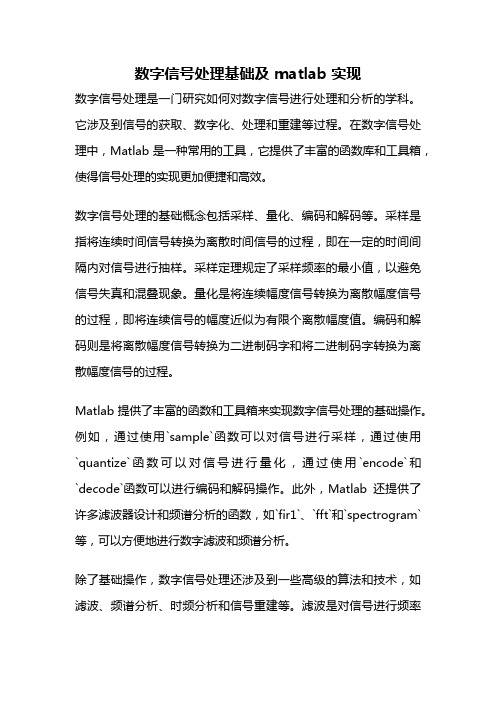
数字信号处理基础及 matlab 实现数字信号处理是一门研究如何对数字信号进行处理和分析的学科。
它涉及到信号的获取、数字化、处理和重建等过程。
在数字信号处理中,Matlab是一种常用的工具,它提供了丰富的函数库和工具箱,使得信号处理的实现更加便捷和高效。
数字信号处理的基础概念包括采样、量化、编码和解码等。
采样是指将连续时间信号转换为离散时间信号的过程,即在一定的时间间隔内对信号进行抽样。
采样定理规定了采样频率的最小值,以避免信号失真和混叠现象。
量化是将连续幅度信号转换为离散幅度信号的过程,即将连续信号的幅度近似为有限个离散幅度值。
编码和解码则是将离散幅度信号转换为二进制码字和将二进制码字转换为离散幅度信号的过程。
Matlab提供了丰富的函数和工具箱来实现数字信号处理的基础操作。
例如,通过使用`sample`函数可以对信号进行采样,通过使用`quantize`函数可以对信号进行量化,通过使用`encode`和`decode`函数可以进行编码和解码操作。
此外,Matlab还提供了许多滤波器设计和频谱分析的函数,如`fir1`、`fft`和`spectrogram`等,可以方便地进行数字滤波和频谱分析。
除了基础操作,数字信号处理还涉及到一些高级的算法和技术,如滤波、频谱分析、时频分析和信号重建等。
滤波是对信号进行频率选择性处理的过程,常用的滤波器包括低通滤波器、高通滤波器、带通滤波器和带阻滤波器。
Matlab提供了许多滤波器设计方法,如IIR滤波器设计和FIR滤波器设计等,可以根据需求选择适当的滤波器类型和设计参数。
频谱分析是对信号频谱特性进行分析的过程,常用的频谱分析方法包括快速傅里叶变换(FFT)、功率谱密度估计和频率变换等。
Matlab提供了一系列的频谱分析函数,如`fft`、`pwelch`和`spectrogram`等,可以进行频谱特性的计算和可视化。
时频分析是对信号的时域和频域特性进行联合分析的过程,常用的时频分析方法包括短时傅里叶变换(STFT)、连续小波变换和Wigner-Ville分布等。
数字信号处理及其MATLAB实现

音频处理
音频压缩
通过降低音频数据的冗余信息,实现音频文件 的压缩,便于存储和传输。
音频增强
去除噪声、提高音质,使音频更加清晰、悦耳 。
语音识别
将语音信号转换为文字,实现人机交互。
图像处理
图像压缩
降低图像数据的冗余信息,实现图像的压缩,便于存储和 传输。
图像增强
改善图像的视觉效果,如锐化、去噪等。
未来发展中,深度学习将在数字 信号处理中发挥越来越重要的作 用,尤其是在人工智能和物联网 等领域的信号处理任务中。
THANKS FOR WATCHING
感谢您的观看
图像识别
对图像进行特征提取和分类,实现目标检测、人脸识别等 功能。
通信系统
调制解调
将数字信号转换为适合 传输的调制信号,以及 将接收到的调制信号还 原为原始数字信号。
信道编码
提高数字信号的抗干扰 能力,降低误码率。
多路复用
提高通信系统的传输效 率,实现多个信号在同 一信道上的传输。
05
数字信号处理的未来发 展
改进的自适应滤波算法将在各种复杂环境中表现出更好的性能,为信号处理领域的发展提供有力支持。
深度学习在信号处理中的应用
深度学习是机器学习领域的一种 新兴技术,通过构建深度神经网 络模型进行学习。在信号处理中 ,深度学习可以用于语音识别、 图像处理、自然语言处理等领域 。
与传统的信号处理方法相比,深 度学习能够自动提取信号中的复 杂特征,并基于这些特征进行分 类或识别。深度学习具有更高的 准确性和鲁棒性,能够处理更加 复杂的信号。
信号以一定的时间间隔 重复。
信号不重复,没有固定 的周期。
信号的频域表示
01
02
Matlab数字信号处理实验报告

Matlab数字信号处理实验报告本次实验使用MATLAB进行数字信号处理操作,目的是熟悉MATLAB中数字信号处理的相关工具箱,并进一步理解数字信号处理的基本概念和算法。
一、实验内容1.信号的生成与显示2.时域分析和频域分析3.滤波器设计4.数字滤波器性能分析二、实验步骤在MATLAB中,使用sawtooth函数生成一个锯齿波信号,并使用plot函数进行时域波形的显示。
代码如下:f = 1000;fs = 40000;t = 0:1/fs:0.01;y = sawtooth(2*pi*f*t);plot(t,y);xlabel('Time (s)');ylabel('Amplitude');title('Sawtooth Wave');时域分析包括波形的观察和参数分析,如幅值、均值、方差等。
频域分析则是对信号进行傅里叶变换,得到其频谱图,包括频率分布和强度分布。
%时域分析amp = max(y)-min(y);mean_y = mean(y);var_y = var(y);设计一个低通滤波器,将高于1kHz的频率成分滤掉。
对滤波后的信号进行时域分析和频域分析,比较滤波前后信号的特征参数和频谱特征,并绘制原始信号、滤波后信号及其频谱图。
subplot(2,2,1);plot(t,y);xlabel('Time (s)');ylabel('Amplitude');title('Sawtooth Wave');subplot(2,2,2);plot(t,y_filt);xlabel('Time (s)');ylabel('Amplitude');title('Sawtooth Wave After Filter');subplot(2,2,3:4);plot(f2,fft_y_filt,'r',f,fft_y,'g');xlabel('Frequency (Hz)');ylabel('Amplitude');title('Sawtooth Wave Spectrum Comparison');legend('After Filter','Before Filter');三、实验结果与分析通过生成并显示一段锯齿波信号,并对其进行时域和频域分析,可以得到该信号的关键信息,如幅值、均值、方差和频率分布特性。
数字信号处理实验源码(matlab)
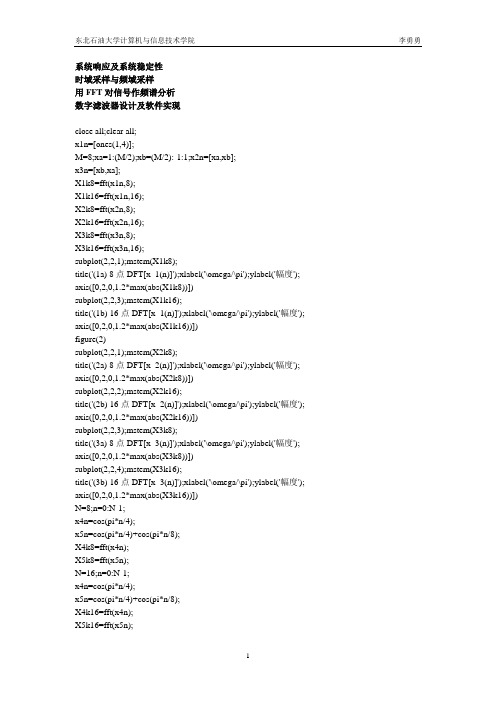
系统响应及系统稳定性时域采样与频域采样用FFT对信号作频谱分析数字滤波器设计及软件实现close all;clear all;x1n=[ones(1,4)];M=8;xa=1:(M/2);xb=(M/2):-1:1;x2n=[xa,xb];x3n=[xb,xa];X1k8=fft(x1n,8);X1k16=fft(x1n,16);X2k8=fft(x2n,8);X2k16=fft(x2n,16);X3k8=fft(x3n,8);X3k16=fft(x3n,16);subplot(2,2,1);mstem(X1k8);title('(1a) 8点DFT[x_1(n)]');xlabel('\omega/\pi');ylabel('幅度'); axis([0,2,0,1.2*max(abs(X1k8))])subplot(2,2,3);mstem(X1k16);title('(1b) 16点DFT[x_1(n)]');xlabel('\omega/\pi');ylabel('幅度'); axis([0,2,0,1.2*max(abs(X1k16))])figure(2)subplot(2,2,1);mstem(X2k8);title('(2a) 8点DFT[x_2(n)]');xlabel('\omega/\pi');ylabel('幅度'); axis([0,2,0,1.2*max(abs(X2k8))])subplot(2,2,2);mstem(X2k16);title('(2b) 16点DFT[x_2(n)]');xlabel('\omega/\pi');ylabel('幅度'); axis([0,2,0,1.2*max(abs(X2k16))])subplot(2,2,3);mstem(X3k8);title('(3a) 8点DFT[x_3(n)]');xlabel('\omega/\pi');ylabel('幅度'); axis([0,2,0,1.2*max(abs(X3k8))])subplot(2,2,4);mstem(X3k16);title('(3b) 16点DFT[x_3(n)]');xlabel('\omega/\pi');ylabel('幅度'); axis([0,2,0,1.2*max(abs(X3k16))])N=8;n=0:N-1;x4n=cos(pi*n/4);x5n=cos(pi*n/4)+cos(pi*n/8);X4k8=fft(x4n);X5k8=fft(x5n);N=16;n=0:N-1;x4n=cos(pi*n/4);x5n=cos(pi*n/4)+cos(pi*n/8);X4k16=fft(x4n);X5k16=fft(x5n);figure(3)subplot(2,2,1);mstem(X4k8);title('(4a) 8点DFT[x_4(n)]');xlabel('\omega/\pi');ylabel('幅度'); axis([0,2,0,1.2*max(abs(X4k8))])subplot(2,2,3);mstem(X4k16);title('(4b) 16点DFT[x_4(n)]');xlabel('\omega/\pi');ylabel('幅度'); axis([0,2,0,1.2*max(abs(X4k16))])subplot(2,2,2);mstem(X5k8);title('(5a) 8点DFT[x_5(n)]');xlabel('\omega/\pi');ylabel('幅度'); axis([0,2,0,1.2*max(abs(X5k8))])subplot(2,2,4);mstem(X5k16);title('(5b) 16点DFT[x_5(n)]');xlabel('\omega/\pi');ylabel('幅度'); axis([0,2,0,1.2*max(abs(X5k16))])figure(4)Fs=64;T=1/Fs;N=16;n=0:N-1;x6nT=cos(8*pi*n*T)+cos(16*pi*n*T)+cos(20*pi*n*T);X6k16=fft(x6nT);X6k16=fftshift(X6k16);Tp=N*T;F=1/Tp;k=-N/2:N/2-1;fk=k*F;subplot(3,1,1);stem(fk,abs(X6k16),'.');box ontitle('(6a) 16点|DFT[x_6(nT)]|');xlabel('f(Hz)');ylabel('幅度'); axis([-N*F/2-1,N*F/2-1,0,1.2*max(abs(X6k16))])N=32;n=0:N-1;x6nT=cos(8*pi*n*T)+cos(16*pi*n*T)+cos(20*pi*n*T);X6k32=fft(x6nT);X6k32=fftshift(X6k32);Tp=N*T;F=1/Tp;k=-N/2:N/2-1;fk=k*F;subplot(3,1,2);stem(fk,abs(X6k32),'.');box ontitle('(6b) 32点|DFT[x_6(nT)]|');xlabel('f(Hz)');ylabel('幅度'); axis([-N*F/2-1,N*F/2-1,0,1.2*max(abs(X6k32))])N=64;n=0:N-1;x6nT=cos(8*pi*n*T)+cos(16*pi*n*T)+cos(20*pi*n*T);X6k64=fft(x6nT);X6k64=fftshift(X6k64);Tp=N*T;F=1/Tp;k=-N/2:N/2-1;fk=k*F;subplot(3,1,3);stem(fk,abs(X6k64),'.');box ontitle('(6a) 64点|DFT[x_6(nT)]|');xlabel('f(Hz)');ylabel('幅度'); axis([-N*F/2-1,N*F/2-1,0,1.2*max(abs(X6k64))])function mstem(Xk)M=length(Xk);k=0:M-1;wk=2*k/M;stem(wk,abs(Xk),'.');box onxlabel('\omega/\pi');ylabel('幅度');axis([0,2,0,1.2*max(abs(Xk))])。
数字信号处理第三版用MATLAB上机实验
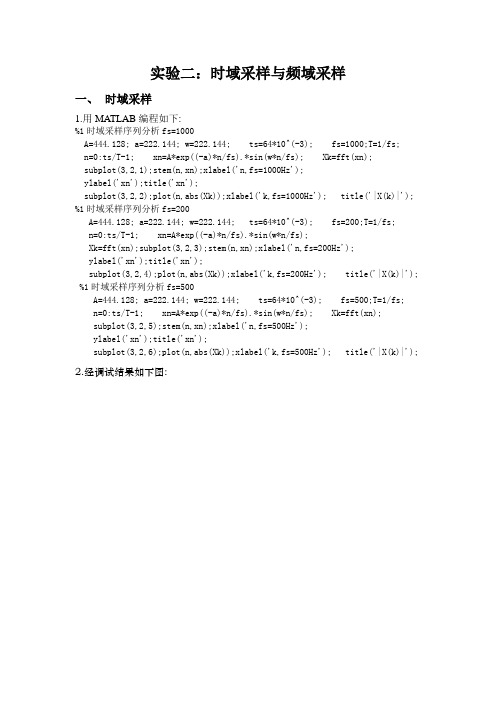
实验二:时域采样与频域采样一、时域采样1.用MATLAB编程如下:%1时域采样序列分析fs=1000A=444.128; a=222.144; w=222.144; ts=64*10^(-3); fs=1000;T=1/fs;n=0:ts/T-1; xn=A*exp((-a)*n/fs).*sin(w*n/fs); Xk=fft(xn);subplot(3,2,1);stem(n,xn);xlabel('n,fs=1000Hz');ylabel('xn');title('xn');subplot(3,2,2);plot(n,abs(Xk));xlabel('k,fs=1000Hz'); title('|X(k)|');%1时域采样序列分析fs=200A=444.128; a=222.144; w=222.144; ts=64*10^(-3); fs=200;T=1/fs;n=0:ts/T-1; xn=A*exp((-a)*n/fs).*sin(w*n/fs);Xk=fft(xn);subplot(3,2,3);stem(n,xn);xlabel('n,fs=200Hz'); ylabel('xn');title('xn');subplot(3,2,4);plot(n,abs(Xk));xlabel('k,fs=200Hz'); title('|X(k)|');%1时域采样序列分析fs=500A=444.128; a=222.144; w=222.144; ts=64*10^(-3); fs=500;T=1/fs;n=0:ts/T-1; xn=A*exp((-a)*n/fs).*sin(w*n/fs); Xk=fft(xn);subplot(3,2,5);stem(n,xn);xlabel('n,fs=500Hz');ylabel('xn');title('xn');subplot(3,2,6);plot(n,abs(Xk));xlabel('k,fs=500Hz'); title('|X(k)|');2.经调试结果如下图:20406080-200200n,fs=1000Hzxnxn2040608005001000k,fs=1000Hz|X (k)|51015-2000200n,fs=200Hzx nxn510150100200k,fs=200Hz |X(k)|10203040-2000200n,fs=500Hzx nxn102030400500k,fs=500Hz|X (k)|实验结果说明:对时域信号采样频率必须大于等于模拟信号频率的两倍以上,才 能使采样信号的频谱不产生混叠.fs=200Hz 时,采样信号的频谱产生了混叠,fs=500Hz 和fs=1000Hz 时,大于模拟信号频率的两倍以上,采样信号的频谱不产生混叠。
使用MATLAB进行数字信号处理的实例介绍

使用MATLAB进行数字信号处理的实例介绍引言:数字信号处理(Digital Signal Processing, 简称DSP)是一门研究如何以数字形式对信号进行采样、分析和处理的学科。
随着数字技术的快速发展,MATLAB作为一种强大的工具,被广泛应用于数字信号处理的研究和实践中。
本文将通过一些实际例子,介绍如何使用MATLAB进行数字信号处理。
一、信号的采样与重构信号的采样与重构是数字信号处理的基础,它涉及到将连续时间信号转换为离散时间信号,并恢复出原始信号。
我们以音频信号为例,使用MATLAB进行信号采样与重构的处理。
1.1 采样:音频信号可以看作是时间上连续的波形,我们需要将其转换为离散形式。
在MATLAB中,可以使用"audioread"函数读取音频文件,并通过设定采样频率和采样位数,将连续的音频信号转换为离散形式。
1.2 重构:采样得到的离散信号需要恢复到连续形式,MATLAB中可以通过"audiowrite"函数将离散信号重新写入到音频文件,并设定采样频率和采样位数恢复出连续的音频信号。
二、傅里叶变换与频谱分析傅里叶变换是一种将信号从时域转换到频域的方法,它可以将信号分解成不同频率的正弦波成分。
频谱分析是数字信号处理中的重要方法,它可以帮助我们了解信号的频率成分和能量分布。
2.1 单频信号的傅里叶变换:我们以一个简单的单频信号为例,使用MATLAB进行傅里叶变换和频谱分析。
首先,我们可以通过构造一个正弦波信号,并设定频率、振幅和采样频率。
然后使用"fft"函数对信号进行傅里叶变换,得到频谱图。
2.2 音频信号的频谱分析:音频信号是复杂的多频信号,我们可以通过将其进行傅里叶变换,得到其频谱分析结果。
在MATLAB中,可以使用"fft"函数对音频信号进行傅里叶变换,并通过频谱图展示信号的频谱信息。
三、数字滤波器设计与应用数字滤波器是数字信号处理中的关键技术,可以帮助我们去除噪声、提取有效信息,满足不同的信号处理需求。
如何使用MATLAB进行数字信号处理

如何使用MATLAB进行数字信号处理MATLAB是一种常用的数学软件工具,广泛应用于数字信号处理领域。
本文将介绍如何使用MATLAB进行数字信号处理,并按照以下章节进行详细讨论:第一章: MATLAB中数字信号处理的基础在数字信号处理中,我们首先需要了解信号的基本概念和数学表示。
在MATLAB中,可以使用向量或矩阵来表示信号,其中每个元素对应着一个离散时间点的信号值。
我们可以使用MATLAB 中的向量运算和函数来处理这些信号。
此外,MATLAB还提供了一组强大的工具箱,包括DSP系统工具箱和信号处理工具箱,以便更方便地进行数字信号处理。
第二章: 数字信号的采样和重构在数字信号处理中,采样和重构是两个核心概念。
采样是将连续信号转换为离散信号的过程,而重构则是将离散信号重新转换为连续信号的过程。
在MATLAB中,可以使用"sample"函数对信号进行采样,使用"interp"函数进行信号的重构。
此外,还可以使用FFT(快速傅里叶变换)函数对离散信号进行频率分析和频谱表示。
第三章: 傅里叶变换与频域分析傅里叶变换是一种常用的信号分析工具,可将信号从时域转换到频域。
MATLAB中提供了强大的FFT函数,可以帮助我们进行傅里叶变换和频谱分析。
通过傅里叶变换,可以将信号分解为不同频率的分量,并且可以通过滤波器和滤波器设计来处理这些分量。
MATLAB还提供了许多用于频域分析的函数,如功率谱密度函数、频谱估计函数等。
第四章: 滤波与降噪滤波是数字信号处理中的重要任务之一,旨在去除信号中的噪声或不需要的频率成分。
在MATLAB中,可以使用FIR和IIR滤波器设计工具箱来设计和实现滤波器。
此外,MATLAB还提供了各种滤波器的函数和滤波器分析工具,如lowpass滤波器、highpass滤波器、带通滤波器等。
这些工具和函数可以帮助我们对信号进行滤波,实现信号降噪和频率调整。
第五章: 时域信号分析与特征提取除了频域分析外,时域分析也是数字信号处理的重要内容之一。
数字信号处理,matlab实验报告
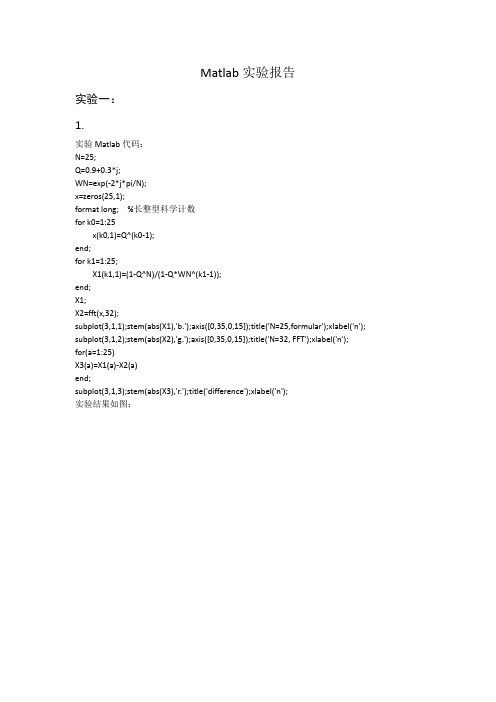
Matlab实验报告实验一:1.实验Matlab代码:N=25;Q=0.9+0.3*j;WN=exp(-2*j*pi/N);x=zeros(25,1);format long; %长整型科学计数for k0=1:25x(k0,1)=Q^(k0-1);end;for k1=1:25;X1(k1,1)=(1-Q^N)/(1-Q*WN^(k1-1));end;X1;X2=fft(x,32);subplot(3,1,1);stem(abs(X1),'b.');axis([0,35,0,15]);title('N=25,formular');xlabel('n'); subplot(3,1,2);stem(abs(X2),'g.');axis([0,35,0,15]);title('N=32, FFT');xlabel('n');for(a=1:25)X3(a)=X1(a)-X2(a)end;subplot(3,1,3);stem(abs(X3),'r.');title('difference');xlabel('n');实验结果如图:实验结论:可以看出基2时间抽选的FFT算法与利用公式法所得到的DFT结果稍有偏差,但不大,在工程上可以使用计算机利用FFT处理数据。
2.实验Matlab代码:N = 1000; % Length of DFTn = [0:1:N-1];xn = 0.001*cos(0.45*n*pi)+sin(0.3*n*pi)-cos(0.302*n*pi-pi/4);Xk = fft(xn,N);k=[0:1:N-1];subplot(5,1,1);stem(k,abs(Xk(1:1:N)));title('DFT x(n)');xlabel('k');axis([140,240,0,6])subplot(5,1,2);stem(k, abs(Xk(1:1:N)),'r');%画出sin(0.3npi)-cos(0.302npi-pi/4) axis([140,160,0,6]);title('sin(0.3*pi*n)-cos(0.302*pi*n) ');xlabel('k');subplot(5,1,3);stem(k, 1000*abs(Xk(1:1:N)),'g');%画出0.001*cos(0.45npi)axis([220,230,0,6]);title('cos(0.45*pi*n) ');xlabel('k');subplot(5,1,4);stem(k,0.01*abs(Xk(1:1:N)),'k');%画%sin(0.3npi)-cos(0.302npi-pi/4)axis([140,160,0,6]);title('sin(0.3*pi*n)-cos(0.302*pi*n) ');xlabel('k');subplot(5,1,5);stem(k, 10*abs(Xk(1:1:N)),'m');%画出0.001*cos(0.45npi)axis([220,230,0,6]);title('cos(0.45*pi*n) ');xlabel('k');实验结果如图:实验结论:由上图及过程可知,当DFT变换长度为1000时所得到的谱线非常理想。
MATLAB下的数字信号处理实现示例

MATLAB 下的数字信号处理实现示例附录一 信号、系统和系统响应1、理想采样信号序列(1)首先产生信号x(n),0<=n<=50n=0:50; %定义序列的长度是50A=444.128; %设置信号有关的参数a=50*sqrt(2.0)*pi;T=0.001; %采样率w0=50*sqrt(2.0)*pi;x=A*exp(-a*n*T).*sin(w0*n*T); %pi 是MATLAB 定义的π,信号乘可采用“.*” close all %清除已经绘制的x(n)图形subplot(3,1,1);stem(x); %绘制x(n)的图形title(‘理想采样信号序列’);(2)绘制信号x(n)的幅度谱和相位谱k=-25:25;W=(pi/12.5)*k;X=x*(exp(-j*pi/12.5)).^(n’*k);magX=abs(X); %绘制x(n)的幅度谱subplot(3,1,2);stem(magX);title(‘理想采样信号序列的幅度谱’);angX=angle(X); %绘制x(n)的相位谱subplot(3,1,3);stem(angX) ; title (‘理想采样信号序列的相位谱’)(3)改变参数为:1,0734.2,4.0,10==Ω==T A αn=0:50; %定义序列的长度是50A=1; %设置信号有关的参数a=0.4;T=1; %采样率w0=2.0734;x=A*exp(-a*n*T).*sin(w0*n*T); %pi 是MATLAB 定义的π,信号乘可采用“.*” close all %清除已经绘制的x(n)图形subplot(3,1,1);stem(x); %绘制x(n)的图形title(‘理想采样信号序列’);k=-25:25;W=(pi/12.5)*k;X=x*(exp(-j*pi/12.5)).^(n’*k);magX=abs(X); %绘制x(n)的幅度谱subplot(3,1,2);stem(magX);title(‘理想采样信号序列的幅度谱’);angX=angle(X); %绘制x(n)的相位谱subplot(3,1,3);stem(angX) ; title (‘理想采样信号序列的相位谱’)2、单位脉冲序列在MatLab 中,这一函数可以用zeros 函数实现:n=1:50; %定义序列的长度是50x=zeros(1,50); %注意:MATLAB 中数组下标从1开始x(1)=1;close all;subplot(3,1,1);stem(x);title(‘单位冲击信号序列’);k=-25:25;X=x*(exp(-j*pi/12.5)).^(n’*k);magX=abs(X); %绘制x(n)的幅度谱subplot(3,1,2);stem(magX);title(‘单位冲击信号的幅度谱’);angX=angle(X); %绘制x(n)的相位谱subplot(3,1,3);stem(angX) ; title (‘单位冲击信号的相位谱’)3、矩形序列n=1:50x=sign(sign(10-n)+1);close all;subplot(3,1,1);stem(x);title(‘单位冲击信号序列’);k=-25:25;X=x*(exp(-j*pi/25)).^(n’*k);magX=abs(X); %绘制x(n)的幅度谱subplot(3,1,2);stem(magX);title(‘单位冲击信号的幅度谱’);angX=angle(X); %绘制x(n)的相位谱subplot(3,1,3);stem(angX) ; title (‘单位冲击信号的相位谱’)4、特定冲击串:)3()2(5.2)1(5.2)()(−+−+−+=n n n n n x δδδδn=1:50; %定义序列的长度是50x=zeros(1,50); %注意:MATLAB 中数组下标从1开始x(1)=1;x(2)=2.5;x(3)=2.5;x(4)=1;close all;subplot(3,1,1);stem(x);title(‘单位冲击信号序列’);k=-25:25;X=x*(exp(-j*pi/12.5)).^(n’*k);magX=abs(X); %绘制x(n)的幅度谱subplot(3,1,2);stem(magX);title(‘单位冲击信号的幅度谱’);angX=angle(X); %绘制x(n)的相位谱subplot(3,1,3);stem(angX) ; title (‘单位冲击信号的相位谱’)5、卷积计算: ∑+∞−∞=−=∗=m m n h m x n h n x n y )()()()()(在MATLAB 中。
Matlab中的模拟和数字信号处理方法

Matlab中的模拟和数字信号处理方法引言:Matlab是一种强大的计算软件工具,广泛应用于科学、工程和数学等领域。
在信号处理领域,Matlab提供了丰富的模拟和数字信号处理方法,极大地方便了信号处理的研究和应用。
本文将介绍一些主要的模拟和数字信号处理方法,以及它们在Matlab中的实现。
一、模拟信号处理方法:1. Fourier变换Fourier变换是一种重要的信号分析方法,可以将信号从时间域转换到频率域,从而揭示信号的频谱特性。
在Matlab中,可以使用fft函数进行傅里叶变换,ifft 函数进行逆傅里叶变换。
通过傅里叶变换,我们可以分析信号的频谱,包括频率成分、功率谱密度等。
2. 滤波滤波是信号处理中常用的方法,可以消除信号中的噪声或者选择感兴趣的频率成分。
在Matlab中,提供了丰富的滤波函数,包括低通滤波器、高通滤波器、带通滤波器等。
通过设计滤波器,我们可以选择不同的滤波方式,如巴特沃斯滤波、切比雪夫滤波等。
3. 时域分析时域分析是对信号在时间域上的特性进行研究,包括信号的振幅、频率、相位等。
在Matlab中,我们可以使用时域分析函数来计算信号的均值、方差、自相关函数等。
通过时域分析,可以更好地了解信号的时间特性,比如周期性、正弦信号等。
二、数字信号处理方法:1. 数字滤波器数字滤波器是将连续时间的信号转换为离散时间的信号,并对其进行滤波处理的一种方法。
在Matlab中,我们可以使用fir1、fir2等函数设计数字滤波器,以满足不同的滤波需求。
数字滤波器可以消除离散信号中的噪声,提取感兴趣的频率成分。
2. 频谱分析频谱分析是对离散信号的频谱进行研究,可以了解信号在频域上的特性。
在Matlab中,可以使用fft函数进行快速傅里叶变换,得到离散信号的频谱。
通过频谱分析,我们可以掌握信号的频率成分、频率幅度等信息。
3. 信号编码信号编码是将模拟信号转换为数字信号的过程,以进行数字信号处理和传输。
数字信号处理 matlab pdf

数字信号处理matlab pdfTornado 是一个Python 的网络框架和异步网络库,起初由FriendFeed 开发。
它使用非阻塞网络I/O,可以处理数以万计的开放连接,非常适合长轮询、WebSockets,以及其他需要长时间实时通信的应用程序。
当使用Tornado 与AJAX 结合时,你通常会有一个Tornado 服务器处理请求并返回一个响应,而这个响应通常是由客户端的JavaScript 通过AJAX 调用来接收的。
以下是一个简单的例子,说明如何使用Tornado 处理AJAX 调用:Tornado 服务器:pythonimport tornado.ioloopimport tornado.webclass MainHandler(tornado.web.RequestHandler):def get(self):self.render("index.html")class AjaxHandler(tornado.web.RequestHandler): async def get(self):data = {"message": "Hello, AJAX!"}self.write(data)def make_app():return tornado.web.Application([(r"/", MainHandler),(r"/ajax", AjaxHandler),])if __name__ == "__main__":app = make_app()app.listen(8888)tornado.ioloop.IOLoop.current().start() HTML 客户端(index.html):html<!DOCTYPE html><html lang="en"><head><meta charset="UTF-8"><meta name="viewport" content="width=device-width, initial-scale=1.0"><title>Tornado AJAX Example</title></head><body><button onclick="fetchData()">Fetch Data</button><script>function fetchData() {fetch('/ajax').then(response => response.json()).then(data => {console.log(data);alert(data.message);}).catch(error => console.error('Error:', error));}</script></body></html>在这个例子中:我们有一个简单的Tornado 服务器,它有两个处理程序:MainHandler 用于呈现主页,AjaxHandler 用于处理AJAX 请求。
数字信号处理实验(吴镇扬版)matlab程序
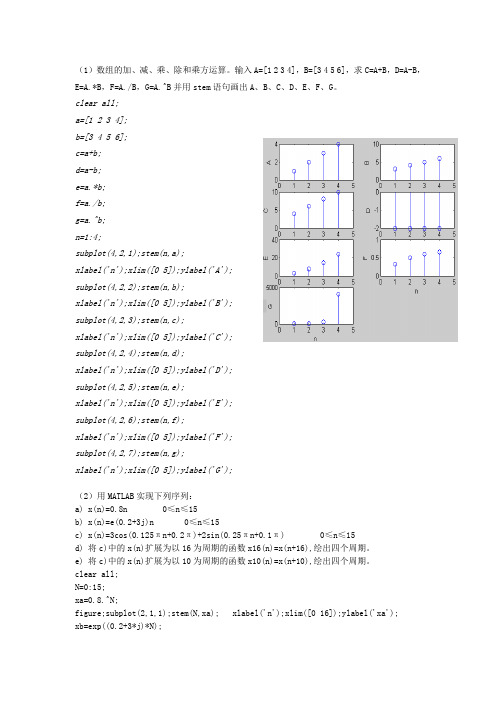
(1)数组的加、减、乘、除和乘方运算。
输入A=[1 2 3 4],B=[3 4 5 6],求C=A+B,D=A-B,E=A.*B,F=A./B,G=A.^B并用stem语句画出A、B、C、D、E、F、G。
clear all;a=[1 2 3 4];b=[3 4 5 6];c=a+b;d=a-b;e=a.*b;f=a./b;g=a.^b;n=1:4;subplot(4,2,1);stem(n,a);xlabel('n');xlim([0 5]);ylabel('A');subplot(4,2,2);stem(n,b);xlabel('n');xlim([0 5]);ylabel('B');subplot(4,2,3);stem(n,c);xlabel('n');xlim([0 5]);ylabel('C');subplot(4,2,4);stem(n,d);xlabel('n');xlim([0 5]);ylabel('D');subplot(4,2,5);stem(n,e);xlabel('n');xlim([0 5]);ylabel('E');subplot(4,2,6);stem(n,f);xlabel('n');xlim([0 5]);ylabel('F');subplot(4,2,7);stem(n,g);xlabel('n');xlim([0 5]);ylabel('G');(2)用MATLAB实现下列序列:a) x(n)=0.8n 0≤n≤15b) x(n)=e(0.2+3j)n 0≤n≤15c) x(n)=3cos(0.125πn+0.2π)+2sin(0.25πn+0.1π) 0≤n≤15d) 将c)中的x(n)扩展为以16为周期的函数x16(n)=x(n+16),绘出四个周期。
matlab数字信号处理案例
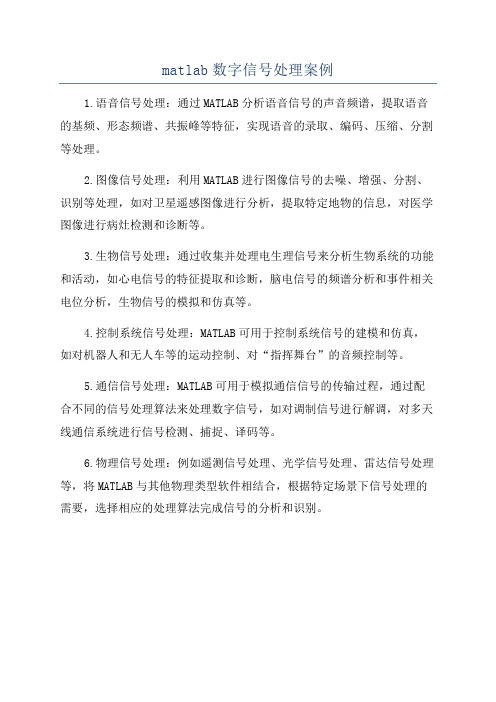
matlab数字信号处理案例
1.语音信号处理:通过MATLAB分析语音信号的声音频谱,提取语音的基频、形态频谱、共振峰等特征,实现语音的录取、编码、压缩、分割等处理。
2.图像信号处理:利用MATLAB进行图像信号的去噪、增强、分割、识别等处理,如对卫星遥感图像进行分析,提取特定地物的信息,对医学图像进行病灶检测和诊断等。
3.生物信号处理:通过收集并处理电生理信号来分析生物系统的功能和活动,如心电信号的特征提取和诊断,脑电信号的频谱分析和事件相关电位分析,生物信号的模拟和仿真等。
4.控制系统信号处理:MATLAB可用于控制系统信号的建模和仿真,如对机器人和无人车等的运动控制、对“指挥舞台”的音频控制等。
5.通信信号处理:MATLAB可用于模拟通信信号的传输过程,通过配合不同的信号处理算法来处理数字信号,如对调制信号进行解调,对多天线通信系统进行信号检测、捕捉、译码等。
6.物理信号处理:例如遥测信号处理、光学信号处理、雷达信号处理等,将MATLAB与其他物理类型软件相结合,根据特定场景下信号处理的需要,选择相应的处理算法完成信号的分析和识别。
数字信号处理及matlab实现 pdf

数字信号处理及matlab实现pdf
数字信号处理是一门研究如何对离散的数字信号进行分析、处理和变换的学科。
它在许多领域中都有广泛的应用,包括通信系统、音频处理、图像处理等。
Matlab是一种强大的数值计算和编程环境,可以用于数字信号处理的实现。
在Matlab中,有很多内置的函数和工具箱可以帮助我们进行数字信号的处理。
首先,我们可以使用Matlab读取和存储数字信号。
Matlab 提供了各种函数来读取不同类型的信号文件,比如wav文件、mp3文件等。
我们可以使用这些函数将信号加载到Matlab中进行后续处理。
同样,Matlab也提供了函数来将处理后的信号保存为文件。
其次,Matlab提供了许多常用的数字信号处理函数,例如滤波器设计、频谱分析、时频分析等。
我们可以利用这些函数对信号进行去噪、滤波、频谱分析等操作。
另外,Matlab还提供了许多工具箱,如信号处理工具箱、音频工具箱等,其中包含了更多高级的处理算法和函数。
此外,Matlab还支持自定义函数和算法的开发。
如果我们想要实现特定的数字信号处理算法,可以使用Matlab编写相应的代码。
Matlab具有简单易用的语法和丰富的函数库,可以帮助我们快速实现各种数字信号处理算法。
总之,通过Matlab实现数字信号处理可以获得高效、灵活
和可靠的结果。
无论是对于初学者还是专业人士来说,Matlab 都是一个非常强大和方便的工具。
数字信号处理matlab pdf
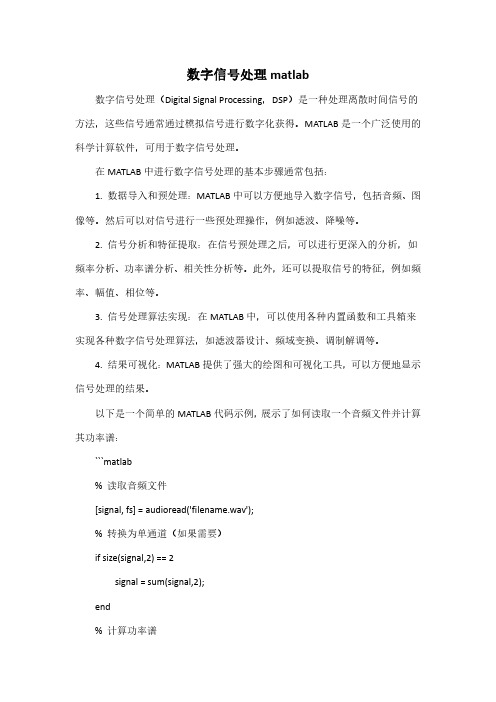
数字信号处理matlab数字信号处理(Digital Signal Processing,DSP)是一种处理离散时间信号的方法,这些信号通常通过模拟信号进行数字化获得。
MATLAB是一个广泛使用的科学计算软件,可用于数字信号处理。
在MATLAB中进行数字信号处理的基本步骤通常包括:1.数据导入和预处理:MATLAB中可以方便地导入数字信号,包括音频、图像等。
然后可以对信号进行一些预处理操作,例如滤波、降噪等。
2.信号分析和特征提取:在信号预处理之后,可以进行更深入的分析,如频率分析、功率谱分析、相关性分析等。
此外,还可以提取信号的特征,例如频率、幅值、相位等。
3.信号处理算法实现:在MATLAB中,可以使用各种内置函数和工具箱来实现各种数字信号处理算法,如滤波器设计、频域变换、调制解调等。
4.结果可视化:MATLAB提供了强大的绘图和可视化工具,可以方便地显示信号处理的结果。
以下是一个简单的MATLAB代码示例,展示了如何读取一个音频文件并计算其功率谱:```matlab%读取音频文件[signal,fs]=audioread('filename.wav');%转换为单通道(如果需要)if size(signal,2)==2signal=sum(signal,2);end%计算功率谱[Pxx,F]=periodogram(signal,[],length(signal),fs);%绘制功率谱图figure;plot(F,10log10(Pxx/max(Pxx)));xlabel('Frequency(Hz)');ylabel('Power/Frequency(dB/Hz)');title('Power Spectrum');```请注意,这只是一个非常基础的示例。
实际应用中,数字信号处理可能涉及更复杂的算法和数据处理。
Matlab实现数字信号处理(源代码)

1 编制程序产生单位抽样序列δ(n) 及δ(n﹣学号),并绘制出图形。
δ(n) %实现单位抽样序列δ(n)程序k=-30:30;delta=[zeros(1,30),1,zeros(1,30)];stem(k,delta)δ(n﹣学号)%实现单位抽样序列δ(n﹣22)程序k=-30:30;delta=[zeros(1,52),1,zeros(1,8)];stem(k,d2 编制程序产生单位阶跃序列u(n) 及u(n﹣学号)及u(n)﹣u(n﹣学号),并绘制出图形。
%实现单位阶跃序列u(n)程序k=-30:30;delta=[zeros(1,30),1,ones(1,30)]; stem(k,delta)%实现阶跃序列u(n﹣22)程序k=-30:30;delta=[zeros(1,52),1,ones(1,8)];stem(k,delta)%实现阶跃序列u(n)﹣u(n﹣22)程序k=-30:30;(1,52),1,ones(1,8)];stem(k,delta)3 编制程序产生正弦序列x(n)= 学号sin(2πn),x(n)= 学号sin(2πn/学号) 及x(n)= 学号sin(2n),并绘制出图形。
%实现正弦序列x(n)= 22sin(2πn)程序n=0:100;x=22*sin(2*n*pi);stem(n,x)%实现正弦序列x(n)= 22sin(2πn/22)程序Array n=0:100;x=22*sin(2*n*pi/22);stem(n,x)n=0:100;x=22*sin(2*n);stem(n,x)4 编制程序产生复指数序列x(n)= e j学号n,并绘制图形。
%实现复指数序列x(n)= ej22n程序n=0:50;x=exp(i*22).^n;xr=real(x);xi=imag(x);xm=abs(x); xa=angle(x); figure;subplot(221);stem(n,xr);title('实部'); subplot(222);stem(n,xi);title('虚部'); subplot(223);stem(n,xm);title('模'); subplot(224);stem(n,xa);title('相角');实部204060虚部0204060模0204060相角5编制程序产生指数序列x(n)= a n,并绘制出图形。
用MATLAB实现数字信号处理
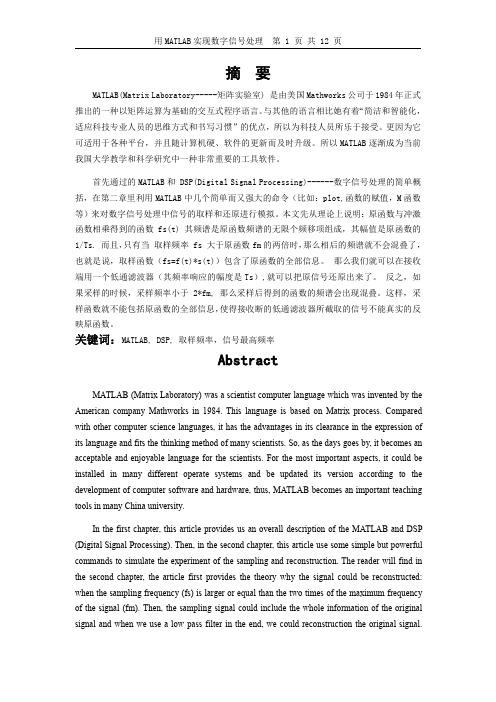
摘要MATLAB(Matrix Laboratory-----矩阵实验室)是由美国Mathworks公司于1984年正式推出的一种以矩阵运算为基础的交互式程序语言。
与其他的语言相比她有着“简洁和智能化,适应科技专业人员的思维方式和书写习惯”的优点,所以为科技人员所乐于接受。
更因为它可适用于各种平台,并且随计算机硬、软件的更新而及时升级。
所以MATLAB逐渐成为当前我国大学教学和科学研究中一种非常重要的工具软件。
首先通过的MATLAB和DSP(Digital Signal Processing)------数字信号处理的简单概括,在第二章里利用MATLAB中几个简单而又强大的命令(比如:plot,函数的赋值,M函数等)来对数字信号处理中信号的取样和还原进行模拟。
本文先从理论上说明:原函数与冲激函数相乘得到的函数fs(t)其频谱是原函数频谱的无限个频移项组成,其幅值是原函数的1/Ts.而且,只有当取样频率fs大于原函数fm的两倍时,那么相后的频谱就不会混叠了,也就是说,取样函数(fs=f(t)*s(t))包含了原函数的全部信息。
那么我们就可以在接收端用一个低通滤波器(其频率响应的幅度是Ts),就可以把原信号还原出来了。
反之,如果采样的时候,采样频率小于2*fm,那么采样后得到的函数的频谱会出现混叠。
这样,采样函数就不能包括原函数的全部信息,使得接收断的低通滤波器所截取的信号不能真实的反映原函数。
关键词:MATLAB,DSP,取样频率,信号最高频率AbstractMATLAB(Matrix Laboratory)was a scientist computer language which was invented by the American company Mathworks in1984.This language is based on Matrix pared with other computer science languages,it has the advantages in its clearance in the expression of its language and fits the thinking method of many scientists.So,as the days goes by,it becomes an acceptable and enjoyable language for the scientists.For the most important aspects,it could be installed in many different operate systems and be updated its version according to the development of computer software and hardware,thus,MATLAB becomes an important teaching tools in many China university.In the first chapter,this article provides us an overall description of the MATLAB and DSP (Digital Signal Processing).Then,in the second chapter,this article use some simple but powerful commands to simulate the experiment of the sampling and reconstruction.The reader will find in the second chapter,the article first provides the theory why the signal could be reconstructed: when the sampling frequency(fs)is larger or equal than the two times of the maximum frequency of the signal(fm).Then,the sampling signal could include the whole information of the original signal and when we use a low pass filter in the end,we could reconstruction the original signal.Otherwise,if the fs<=2fm,the sampling signal could not provide us the whole information of the original signal,thus based on this we could not reconstruct the original signal.Key word:MATLAB,DSP,sampling frequency,the maximum frequency of the signal第一章绪论第一节MATLAB语言简介1.1.1MATLAB语言概述MATLAB(Matrix Laboratory-----矩阵实验室)是一种科学计算软件,适用于工程应用各领域的分析设计与复杂计算,它使用方便,输入简捷运算高效且内容丰富,很容易由用户自行扩展。
数字信号处理及MATLAB实现课程设计
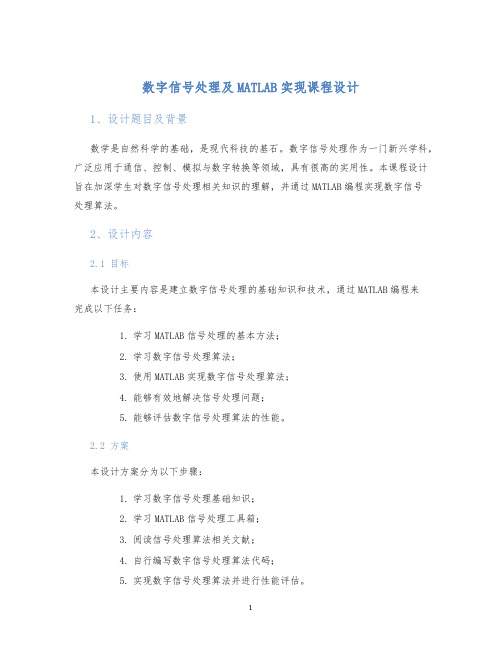
数字信号处理及MATLAB实现课程设计1、设计题目及背景数学是自然科学的基础,是现代科技的基石。
数字信号处理作为一门新兴学科,广泛应用于通信、控制、模拟与数字转换等领域,具有很高的实用性。
本课程设计旨在加深学生对数字信号处理相关知识的理解,并通过MATLAB编程实现数字信号处理算法。
2、设计内容2.1 目标本设计主要内容是建立数字信号处理的基础知识和技术,通过MATLAB编程来完成以下任务:1.学习MATLAB信号处理的基本方法;2.学习数字信号处理算法;3.使用MATLAB实现数字信号处理算法;4.能够有效地解决信号处理问题;5.能够评估数字信号处理算法的性能。
2.2 方案本设计方案分为以下步骤:1.学习数字信号处理基础知识;2.学习MATLAB信号处理工具箱;3.阅读信号处理算法相关文献;4.自行编写数字信号处理算法代码;5.实现数字信号处理算法并进行性能评估。
具体步骤如下:2.2.1 学习数字信号处理基础知识数字信号处理作为一门新兴学科,需要学习其基础知识,包括数字信号的表示、采样、量化、傅里叶变换等。
本步骤需要通过阅读相关学科教材和参考书籍进行学习。
2.2.2 学习MATLAB信号处理工具箱MATLAB是一种广泛应用于各个领域的高级技术计算软件,其信号处理工具箱提供了一系列的信号处理函数和工具,能够有效地帮助用户实现数字信号处理算法。
本步骤需要通过学习MATLAB官方文档和实际操作来学习MATLAB信号处理工具箱。
2.2.3 阅读信号处理算法相关文献数字信号处理领域有许多先进的算法和方法,如数字滤波、快速傅里叶变换等。
本步骤需要通过阅读学术文献、参考书籍和网络文章等途径来学习信号处理算法。
2.2.4 自行编写数字信号处理算法代码本步骤需要结合前面所学知识和使用MATLAB工具箱来编写数字信号处理算法代码。
编写代码的过程需要仔细分析算法的原理和实现细节,并运用相关的编程技巧来实现。
2.2.5 实现数字信号处理算法并进行性能评估本步骤需要将前面编写的数字信号处理算法代码进行实际实现,并进行性能评估。
- 1、下载文档前请自行甄别文档内容的完整性,平台不提供额外的编辑、内容补充、找答案等附加服务。
- 2、"仅部分预览"的文档,不可在线预览部分如存在完整性等问题,可反馈申请退款(可完整预览的文档不适用该条件!)。
- 3、如文档侵犯您的权益,请联系客服反馈,我们会尽快为您处理(人工客服工作时间:9:00-18:30)。
数字信号处理的matlab实现简谐振动的特性完全取决于振幅、频率、初相位角。
x1 = (0.5).^t;x1 = 0.5* sin(2*pi*f*t+pi/4);x1 = [(n - n0) >= 0]; %阶跃信号x1 = [(n-n0) == 0]; %脉冲信号y = sin(pi * x +eps)./(pi * x +eps);%sinc function,eps是matlab系统的精度,这里防止被零除n = [-10:10];alpha = -0.1 + 0.3 * j;x = exp(alpha * n);%复指数信号rx = real(x);ix = imag(x);mx = abs(x); %振幅px = (180/pi) * angle(x); % 相位,并转换为度x = rand(1,10);x = randn(1,10); %guass series numbersxp = [x x x x x];x2 = fliplr(x);%左右折叠第二章信号%test sampling ruledt = 0.01; %samping frequence for draw 100Hzt = 0:dt:1;f = 10;x = sin(2 * pi * f * t + 0.3);dt1 = 0.1; t1 = 0:dt1:1;%10Hzx1 = sin(2 * pi * f * t1 + 0.3);dt2 = 0.05; t2 = 0:dt2:1;%10Hzx2 = sin(2 * pi * f * t2 + 0.3);subplot(3,1,1), plot(t, x);title('f = 10Hz, fs = 100Hz');subplot(3,1,2), plot(t1, x1), hold on, stem(t1, x1), plot(t, x);title('f = 10Hz, fs = 10Hz');subplot(3,1,3), plot(t2, x2), hold on, stem(t2, x2), plot(t, x);title('f = 10Hz, fs = 20Hz');基本信号:x1 = (0.5).^t; %指数信号x1 = 0.5* sin(2*pi*f*t+pi/4); %余弦信号x1 = [(n - n0) >= 0]; %阶跃信号x1 = [(n-n0) == 0]; %脉冲信号y = sin(pi * x +eps)./(pi * x +eps);%sinc function,eps是matlab系统的精度,这里防止被零除,sinc函数信号n = [-10:10];alpha = -0.1 + 0.3 * j;x = exp(alpha * n);%复指数信号rx = real(x);ix = imag(x);mx = abs(x); %振幅px = (180/pi) * angle(x); % 相位,并转换为度x = rand(1,10); %随机信号x = randn(1,10); %高斯随机序列xp = [x x x x x]; %复制信号运算:时移,倒置,尺度改变x2 = fliplr(x);%左右折叠信号加信号微分和积分% test2 微分和积分clear all; clc;dt = 0.01; t = 0:dt:4*pi;y = sin(t);y1 = diff(y)/dt; % 微分,dt为采样间隔for ii = 1:length(y) %积分,dt为采样间隔y2(ii) = sum(y(1:ii)) * dt;endsubplot(3,1,1), plot(t, y);subplot(3,1,2), plot(t, [0 y1]); %微分后信号比原信号少一个元素,用零补subplot(3,1,3), plot(t,y2);grid on;xlabel('Time/s');ylabel('Amplitude');信号乘注意:若参与信号乘的两个信号长度不一样,则必须进行转换之后才能在matlab中进行操作。
% test3 信号乘,滤波器滤波。
注意振幅谱的绘制方法clear all; clc;dt = 0.02; df = 1/(6000 * dt);% 采样间隔为0.02s,则2min内数据个数为6000,df为信号频率分辨率n = 0:2999; %折叠频率之前(取前3000个)数据进行操作f = n * df; %给出频率序列sig = rand(1, length(n)); % 运用随机函数产生信号振幅谱filt = [ones(1, 5/df), zeros(1, (length(n) - 5/df))]; % 理想滤波器幅频响应函数subplot(3,1,1), plot(n * df, sig);subplot(3,1,2), plot(n * df, filt, 'LineWidth', 3);subplot(3,1,3), plot(n * df, sig .* filt);grid on;xlabel('Time/s');ylabel('Amplitude');信号奇偶性第三章Fourier变换一个带相位的余弦函数可以看成一个不带相位的正弦函数与一个不带相位的余弦函数的合成。
谐波函数是周期函数中最简单的函数,它描述的也是最简单的周期现象,在实际中遇到的周期现象往往比它复杂的多。
但这些复杂函数均在一定近似程度上可分解为不同频率的正弦函数和余弦函数。
可以将一种复杂的函数分解为一系列不同频率的正弦函数和余弦函数。
1 周期函数的Fourier变换连续傅里叶级数2 离散Fourier变换离散傅里叶级数对于一个有限长观测数据序列来说,使用Fourier级数法求得的各种周期或频率都是有限的。
????=1????=???????=,T为所取数据总的时间长度????Nyquist频率由取样间隔???来决定,为取样间隔2倍的倒数。
Ck表示了k次谐波的振幅大小。
观察哪些分量的振幅大,哪些分量的振幅小,看出所给波列种含有哪种频率成分,如果我们想滤掉某种频率的波,直接去掉该频率的谐波即可。
我们通常用频率作为横坐标,用振幅作为纵坐标绘出图形来研究频率与振幅的关系,简称为振幅谱。
3 信号的Fourier分解与合成举例% test3 DFTclear allN = 256; dt = 0.05; % data numbers and sampling intervel,sampling frequence is 20Hzn = 0:N-1; t = n * dt; % 序号序列和时间序列x1 = sin(2 * pi * t);x2 = 0.5 * sin(2 * pi * 5 * t);x = sin(2 * pi * t) + 0.5 * sin(2 * pi * 5 * t); %signals addm = floor(N/2) + 1; %down for integera = zeros(1, m);b = zeros(1, m);for k = 0:m-1for ii = 0:N-1a(k+1) = a(k+1) + 2/N * x(ii+1) * cos(2 * pi * k * ii/N);%matlab's array index must be increase from 1 b(k+1) = b(k+1) + 2/N * x(ii+1) * sin(2 * pi * k * ii/N);endc(k+1) = sqrt(a(k+1).^2 + b(k+1).^2);endif (mod(N, 2) ~= 1) a(m) = a(m)/2;endfor ii = 0:N-1xx(ii + 1) =a(1)/2;for k = 1:m-1;xx(ii + 1) = xx(ii + 1) + a(k+1) * cos(2 * pi * k * ii/N) + b(k+1) * sin(2 * pi * k * ii/N);endendsubplot(4,1,1), plot(t, x1); title('orignal signal One '),xlabel('Time/s');subplot(4,1,2), plot(t, x2); title('orignal signal Two'),xlabel('Time/s');%subplot(4,1,1), plot((0:N-1) * dt, xx);title('Composedsitgnal');subplot(4,1,3), plot(t, x); title('orignal signal'),xlabel('Time/s');subplot(4,1,4), plot((0:m-1)/(N * dt), c), title('Fouriertransform'),xlabel('Frequence/Hz'),ylabel('Amplitude'); 此处的1Hz和5Hz的振幅与原来信号振幅不完全一致,是由于数据采样点较少导致的,即N较小。
离散有限信号的频谱为周期谱。
方波及其Fourier分解系数和合成与原始方波信号对比% test4 方波的DFT分解和合成clear all; close allN = 200; dt = 4/N;for n = 1:N %方波信号if (n * dt >= 2)x(n) = 0.8;elsex(n) = -0.8;endendfigure(1)subplot(2,1,1), plot((1:N) * dt, x), hold on;plot((1:N) * dt, zeros(1, N), 'k'), xlabel('Time/s'), title('Orignal signal');a = zeros(1, N),b = zeros(1, N);nn = floor(N/2) + 1;for k = 0:nn - 1%DFT分解方波信号,得到a和ba(k+1) = 0;b(k+1) = 0;for ii = 0:N-1a(k+1) = a(k+1) + 2/N * x(ii + 1) * cos(2 * pi * k * ii /N);b(k+1) = b(k+1) + 2/N * x(ii + 1) * sin(2 * pi * k * ii /N);endc(k+1) = sqrt(a(k+1).^2 + b(k+1).^2);endsubplot(2,1,2), plot((0:nn - 1) / (N * dt), c);title ('DFT'), xlabel('Frequence/Hz'),ylabel('Amplitude');m = input('Input the max k value: ');%观察m的值不到N/2的时候的合成情况if (m > floor(N/2) + 1)error('Too large!');endif (mod(N, 2) ~= 1) a(nn) = a(nn)/2;endfor ii = 0:N-1xx(ii+1) = a(1)/2;for k = 1:mxx(ii+1) = x(ii+1) + a(k+1) * cos(2 * pi * k * ii /N) + b(k+1) * sin(2 * pi * k * ii /N);%合成信号endendfigure(2)plot((1:N) * dt,xx, (0:N-1) * dt, x)hold onplot((1:N) * dt, zeros(1, N), 'k'), xlabel('Time/s'), title('composed signal');最基本的Fourier变换的形式。
